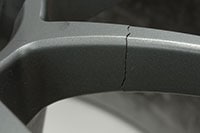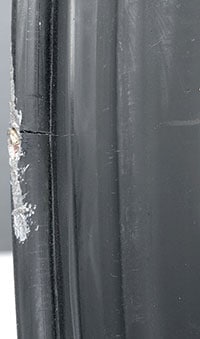For real driving enthusiasts there aren't many feelings that equal the excitement of running laps on a racetrack at their vehicles' performance limit. And while race tracks were once only accessible to race-prepared cars, today many car clubs and some professional driving schools allow drivers to learn more about high performance driving as they run their street cars (with relatively few modifications) on the same tracks as their racing heroes. For that matter, it is not unusual to have more track time (enough to drive several hundred track miles per day) at a typical club event or driver's school than most actual race weekends. And while it's common sense that track use will increase the wear on a car's tires, brakes and shocks, there are less obvious critical components that also wear out...like its wheels! Yes, wheels do wear out. Or better stated, they fatigue.
Because wheels are so critical to the driver's safety, top racing teams visually inspect their wheels at the track, monitor the total number of hours they are used, and crack test them on a periodic basis. Any wheel that shows signs of fatigue or age is discarded and replaced. Many professional race sanctioning bodies require that their race participants' wheels meet strict standards when new and that previously used wheels be recertified periodically.
Unfortunately, the same rigorous wheel inspection procedures are not typical for many driving enthusiasts who use their vehicles on the track. Maybe it's because wheels are typically so trouble-free that they are often overlooked. But if let go for too long, wheels subjected to high stress track conditions can fail.
When it comes to wheel fatigue, it is important to remember that it is caused by a combination of the frequency and magnitude of the stresses it encounters. While small stresses can be accommodated for thousands of cycles, large stresses accelerate the wheel's fatigue factor and the number of fatigue-free cycles is significantly reduced. So what is it about track use that reduces the life expectancy of wheels? Let's explore some of the important factors.
All wheels flex as they are driven around a corner. In normal street driving the amount of flex is minimal. However, since today's Track & Competition DOT tires almost match the performance of yesterday's racing tires, every corner that is taken at the limit of traction on the track causes significantly more flex. It's the combination of the extra tire grip and the resulting extra flex that fatigues wheels faster when used on the track.
During track use, wheels will often reach temperatures never encountered on the street as they help dissipate brake heat. This constant cycling between the ambient temperature and the extremes encountered on the track can increase the fatigue rate of alloy wheels.
In normal street driving, wheels are typically removed from the vehicle only when the tires are being rotated (typically every 5,000 miles) or replaced (typically every 25,000 to 40,000 miles). But when used on the track, wheels are typically removed from the vehicle at the start and finish of each day, as well as, anytime the vehicle's brakes or suspension are being serviced. Additionally DOT-legal competition tires wear out and are replaced much more frequently than normal street tires. These extra tire mountings and vehicle installations can increase wheel fatigue as they wear out the wheel's lug seats and the vehicle's lug nuts/studs or lug bolts/hubs.
So what should track drivers do to take better care of their wheels and minimize the possibility of wheel failure?
Before Going on the Track
Make certain that the wheel's installation hardware is correct for the vehicle and in good condition. Since almost all of today's cars are designed with hub-centric wheels which transfer the vehicle's load from the center of the wheel to the car's hub (and allow the lug nuts/bolts to just hold the wheel against the hub), it is important that track wheels continue to be hub-centric to help distribute the forces encountered on the track. If an aftermarket wheel requires special centering rings to properly fit it to the hub, be sure they are installed correctly.
When any non-Original Equipment wheel or lug nut/bolt is used on the vehicle, it is important that there is sufficient thread engagement between the lug nuts/bolts and the vehicle's hub. It's acceptable to increase the thread engagement by installing longer wheel studs in the hubs after verifying that the lug nuts don't bottom out on the studs. However, if the vehicle uses lug bolts, they must maintain as close to the original amount of thread engagement as possible. Longer lug bolts may cause interference with the parking brake or other components inside the hub.
Always torque the wheel's lug nuts/bolts to the hub using a "star" pattern until the vehicle's correct torque value is reached.
Note: If wheel spacers that are thicker than the height of the hub are used, they also need to be wheel- and hub-centric to help distribute forces.
While on the Track
Drivers participating in track events must remain aware of their vehicle's normal characteristics throughout every on-track session. Any changes in their vehicle's normal performance and handling, or the presence of any unusual noise and/or vibration is cause for immediate concern and a thorough inspection of the vehicle should be done until the source of the problem is located and corrected.
At the beginning of each track session, drivers should concentrate on knocking noises and/or vibrations that could indicate a potential problem. While minor noises and/or minute vibrations may allow the driver to continue to the pits at reduced speed, noises and/or vibrations that suddenly appear, rapidly increase in intensity or become severe are cause for the driver to clear the circuit as well as, circumstances permitting, come to an immediate and controlled stop with regard to other drivers.
While it may seem innocent enough, straightening out the track by ditch-hooking corners and driving aggressively over the rumble strips and curbing will shorten wheel life. Drivers should also be wary of potential damage caused by off-track excursions that result in direct contact or bottoming of the suspension. One encounter with trackside curbing can be enough to damage the wheel and lead to failure.
After Coming Off of the Track
At the end of every track day the wheels should be allowed to cool, should be cleaned front and back, and inspected for minute cracks, impact damage and runout. At the first sign of a crack appearing (regardless of size or location) or an indication the wheel has been bent, it should be removed from service and replaced with a good wheel.
Every time new tires are mounted, each wheel should be inspected to verify that it is round and true. If it is found to be bent, it should be removed from service and replaced with a good wheel.
If the wheel has been used for an extended period of time, you may want to have a local machine shop professionally crack test it in the off-season to ensure it can be subjected to another year of track use.
Wheels are a critical component to your car. Because they tend to fatigue slowly, periodic inspection will usually reveal the signs of aging and use (such as minute cracks in the wheels spokes or near the bolt holes) before they can become a serious problem. If overlooked, once a crack has formed it will concentrate the stresses in the weak area and allow the crack to spread until the wheel fails.
Lug nuts, lug bolts and wheel studs are designed to outlast the lifetime of a vehicle used for regular street driving. However, wheel hardware subjected to competition/track use typically experiences significantly more severe service conditions and a greater number of installation/removal cycles in one autocross/racing season. The condition of wheel hardware should be inspected frequently and replaced periodically.
It is important to note that track use and/or participation in racing voids the manufacturers' warranties of all street wheels.



